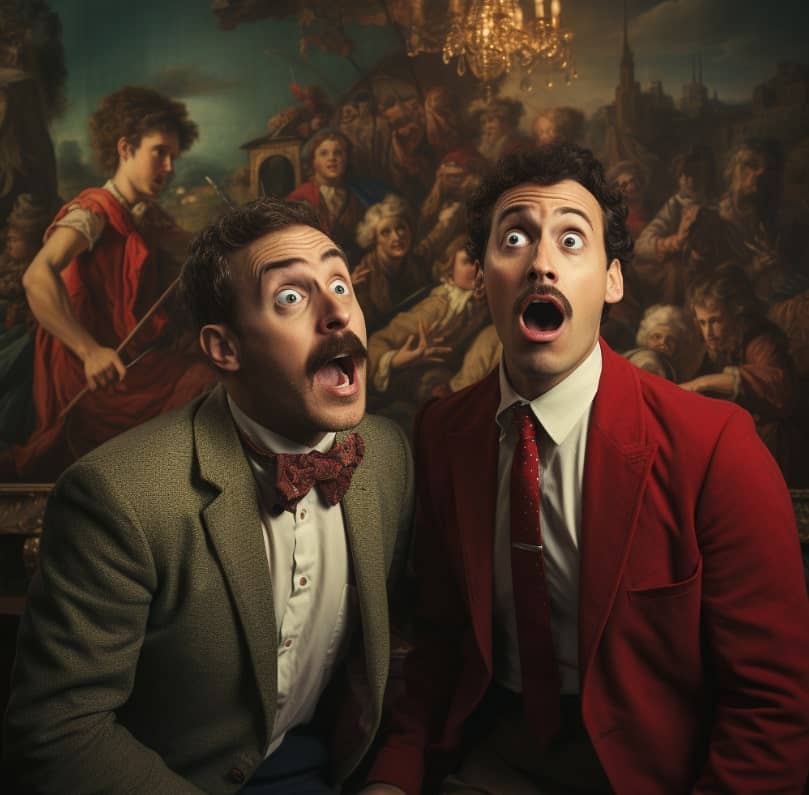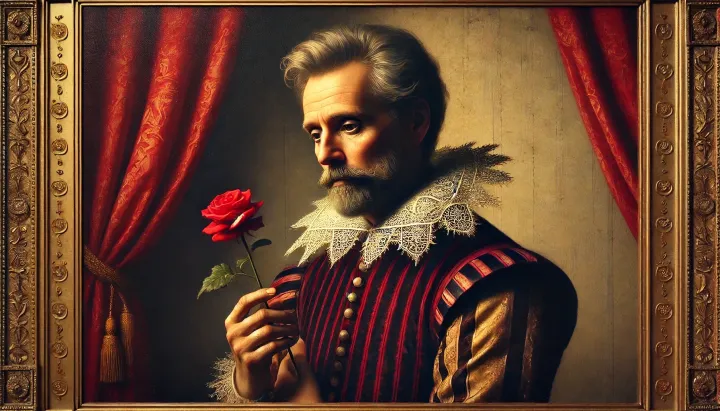Improv History in a Nutshell

You may know the history of improv for your local comedy club or city, but have you ever sat to study improv history of the world? Improv dates back millions of years to the first living organism's mating rituals. No but in all seriousness it’s important to know the roots of this wonderful art form that’s caused more belly laughs, profuse sweating, spilled drinks, and broken props than any other theatrical endeavor. As most of you probably already know, improvisational theatre, often referred to as improv, is a form of theatre where most, if not all, of what is performed is unplanned or unscripted, spontaneously crafted by the performers themselves. It's an art form that encompasses a broad range of styles, from comedic to non-comedic (that’s right, serious improv), used not only in theatrical performances but also in film, television, and even psychotherapy. As mentioned in our first ever article, theatre and improv especially can be an extremely cathartic exercise for some, from any combination of the social or physical or creative aspects. But we’re here to give you some interesting nuggets to impress your friends with, so let’s comb through history and see what made improv the art form it is today.
The documented roots of improvisational theatre can be traced back to 391 BC with the Atellan Farce. For those unfamiliar, the Atellan Farce, also known as the Oscan Games, was a popular form of masked improvised theatre in Ancient Rome, believed to have originated in the Oscan town of Atella around 391 BC (before Rome occupied it in 210 BC). These farces, which lasted for more than 500 years, were performed in Oscan and Latin and generally featured comedic sketches that entertained audiences during holidays and market days. Just try to imagine what they would joke about.
The farces included a variety of stock characters such as Maccus, Buccus, Manducus, Pappus, Centunculus, and Dossennus, who represented various comedic stereotypes such as the fool, the glutton, the arrogant soldier, and the easily deceived old man. Some believe these characters may have inspired later Commedia dell'arte stock characters like Pantalone and Pulcinella, although this conclusion remains speculative. Initially, the farces were improvised and not recorded, with the subjects and characters decided upon just before the performance began, like the original Whose Line Is It Anyway. The performers were sons of Roman citizens, with professional actors being excluded. The simple prose dialogues were supplemented by songs and accompanied by lively gesticulation. The Atellan plays first gained popularity in Rome in the 3rd century B.C, and then saw a revival in the 1st century B.C. thanks to some stability after the Second Punic War. During this revival, professional actors were no longer excluded from playing the stock characters' roles, finally giving them an opportunity to lighten up. Notable authors who contributed to this form included the dictator Sulla, Quintus Novius, and Lucius Pomponius of Bologna (that’s right, Bologna is a real place and you better put some respect on the name). Pomponius is believed to be the "founder" of the Atellan Farce plays.
However, the farces often faced criticism for their coarseness and obscenity, typically from older crowds. In the 1st century A.D., Emperor Tiberius and other officials began to suppress the farces due to their licentious content and disruptive influence on public peace. The players were eventually banished from Italy in 28 A.D. Despite this, some performances of Atellan Farces were recorded during the reign of Emperor Hadrian, from 117 to 138 A.D. Good on him for having a sense of humor and keeping the spirit alive.
Fast forwarding a bit, the art of improv gained more prominence from the 16th to the 18th centuries with the performances of commedia dell'arte actors on the streets of Italy. Note how this coincides with tickets coming into more common use, as we discussed in our previous post on ticketing history. Performers improvised based on a rough outline rather than a strict script. In the late 19th century, renowned theatrical theorists like the Russian Konstantin Stanislavski and the French Jacques Copeau, founders of two major streams of acting theory, greatly relied on improvisation in actor training and rehearsal. We’ve mentioned these names before, and it may be worthwhile to dedicate an article to each in the future.
Modern improvisational theatre owes much to the contributions of figures such as Dario Fo, recognized for his highly improvisational style. Let's talk about Dario for a minute. Picture this: a playwright, actor, theatre director, stage designer, songwriter, political campaigner for the Italian left-wing, and even a Nobel Prize winner in Literature in 1997. Quite the repertoire, wouldn't you agree? You could say he was a real stage sensation with his work performed in over 30 languages and across the globe.
Fo had a penchant for improvisation and recovering "illegitimate" forms of theatre, such as those performed by medieval strolling players and, most famously, the traditional Italian style of commedia dell'arte. From the 1960s onwards, his work was a well-seasoned mix of critiques about assassinations, corruption, organised crime, and even theology. His piece de resistance, Mistero Buffo, was performed over a 30-year period and became a bit of a sensation (and not just the good kind), drawing the ire of the Catholic Church.
If we were to translate one of Fo's most famous plays, Non Si Paga! Non Si Paga! it would read "Can't Pay? Won't Pay!" and has become a common saying in English. His work was hailed for capturing "something universal in actions and reactions of the working class." But before he stole the show on the global stage, Fo was just a boy born in Lombardy, near the eastern shore of Lago Maggiore. From a young age, he was introduced to storytelling by his grandfather and local craftsmen. During World War II, Fo got drafted into Mussolini's army, but being the rebel he was, he deserted – not once but twice – and then helped his father to smuggle refugees and Allied soldiers to Switzerland. Quite the escapade, and those events were surely a great source of inspiration. After the war, he started studying at the Brera Academy and then at the Politecnico di Milano. However, the architecture life wasn't for Fo, so he left before his final exams and took to the stage instead, becoming part of the piccoli teatri movement, where he began to present improvised monologues.
Fo was an artist through and through, inspired by the likes of Beolco, Brecht, Chekhov, De Filippo, Gramsci, Mayakovsky, Molière, Shaw and Strehler. He may have been a bit of a jester, poking fun at authority, but his work upheld the dignity of the downtrodden. So, here's to Dario Fo, the theatre world's lovable rogue and undeniable genius! We’ll likely cover Fo again in the future in more detail as his body of work spans over five decades.
Dudley Riggs, an American, is often cited as the first to incorporate audience suggestions into improvised sketches on stage. Later, Viola Spolin further developed improv exercises during the mid-20th century, leading to the first book providing specific techniques for learning improvisational theatre: Improvisation For The Theater. And Clive Barker's Theatre Games, published in 1977, helped spread improv ideas worldwide. Fun fact: Clive Barker directed Hellraiser, the cult classic from 1987 based on his novella, The Hellbound Heart. Mr. Barker has of course created many wonderful works in the realms of screenplays, television, films, short stories with his own illustrations, and even comic books.
One other particularly influential figure was British playwright and director Keith Johnstone, who wrote Impro: Improvisation and the Theatre. He invented Theatresports, a staple of modern improvisational comedy and a significant influence on popular television shows like Whose Line Is It Anyway? In the United States, Viola Spolin played a vital role in shaping the first generation of modern American improvisers at The Compass Players in Chicago, which eventually gave rise to The Second City. Her son, Paul Sills, along with David Shepherd, launched The Compass Players. Following its closure, Paul Sills initiated The Second City, marking the beginning of the organized improv movement in Chicago. Now how many of your friends could tell you how The Second City began? Ok don’t count the friends that have read the plaques at the building.
Many comedic improv rules (or guidelines rather) were formalized in Chicago in the late 1950s and early 1960s. From most accounts, David Shepherd provided the philosophical vision, while Elaine May was essential in developing improvisation premises. Mike Nichols, Ted Flicker, and Del Close were among her primary collaborators. In 1953, Shepherd, Paul Sills, and Eugene Troobnick started the Playwrights Theatre Club in Chicago. If you think the Avengers had a good ensemble, you haven't seen anything yet. Their team included Elaine May as mentioned, but also Sheldon Patinkin, and Ed Asner, all legends in their own right. This band of merrymakers was essentially the Big Bang of improv, leading to the creation of the Compass Players and later, the Second City.
Speaking of the Compass Players, Shepherd and Paul Sills founded this group in 1955, and it's safe to say they "compass"-itately revolutionized entertainment (wink, wink). Ever heard of Mike Nichols or Alan Arkin? Yeah, you have Shepherd to thank for launching their careers.
When The Second City opened its doors on December 16, 1959, Viola Spolin began training new improvisers, laying the foundation for modern improv training. Improv was becoming a very serious business. Later, Spolin's classes were handed over to Jo Forsberg, who further developed Spolin's methods into a one-year course. This eventually became The Players Workshop, the first official school of improvisation in the United States. During this time, Forsberg trained many performers who later starred on The Second City stage. As all of us know, The Second City has since produced comedy stars like Mike Myers, Tina Fey, Steve Carell, and many others.
Meanwhile, across the Atlantic, Keith Johnstone's group The Theatre Machine was touring Europe, birthing Theatresports in the process. When Johnstone moved to Canada, improv took root there, and Toronto became a rich hub for the improvisation tradition, providing Toronto with immense street cred. Interestingly enough in 1973, Shepherd decided to put improvisers to the test with the ImprovOlympic, a theatrical sporting event. Imagine improv as an Olympic sport, complete with the sweat, drama, and upsets. This event moved to Chicago in 1981 and later inspired the Canadian Improv Games in Ottawa.
In the 1980s and 90s, improv continued to evolve and spread throughout the land. Dick Chudnow founded ComedySportz in Milwaukee, and the organization has since grown internationally. On the other side of the USA, San Francisco's The Committee theatre, a creation of Chicago's Second City alumni, nurtured several improvisation companies in the art. They, in turn, spread improv further, with people like Michael Bossier and John Elk bringing shortform improv to England and forming Spaghetti Jam in San Francisco (hit us up Spaghetti Jam we’d love a chance to manage your tickets!).
Political improvisation's roots also arguably developed during this period, influenced by figures such as Jerzy Grotowski, Peter Brook, Augusto Boal, and San Francisco's The Diggers. The works of each of those names is enough to make your head spin, a tale for another time. English actress and director Joan Littlewood also made extensive use of improv in developing plays for performance.
The Annoyance Theatre, founded in Chicago in 1987, emphasized longform improvisation and has become home to the longest-running musical improv show. Similarly, in 2012, Lebanese writer and director Lucien Bourjeily used improvisational theater techniques to create the multi-sensory play 66 Minutes in Damascus, considered an extreme example of interactive improvised theatre.
Online theatrical improvisation, or netprov, developed by Rob Wittig and Mark C. Marino, emerged as a new form of improv. This form uses social media to engage audiences in dynamic fictional scenarios evolving in real-time.
Improvisational comedy, in modern western practice, generally falls into two categories: shortform and longform. Shortform improv consists of short scenes driven by an audience suggestion, often built from a predetermined game, structure, or idea. Viola Spolin, who called these exercises "theatre games," originally created many of these short form exercises.
In contrast, longform improv creates shows in which short scenes are often interconnected by story, characters, or themes. Notable longform structures include the Harold, developed by ImprovOlympic co-founder Del Close. Many cities in North America and the United Kingdom have vibrant longform improvisation scenes, and the art form continues to grow globally. Today, many celebrated actors, such as Will Ferrel, Tina Fey, and Steve Carrel, found their start in longform improv, proving the significant impact of this creative discipline on modern entertainment.
With every article we hope to help undercover the extremely rich and vibrant cultures and subcultures of theatre and comedy. While many of our posts may seem to dive a little deeper, they are all still barely scratching the surface in the industry. With luck and time we hope to develop some valuable topics of discussion for some of these legends, and with even more like get their takes to include in these write ups. Thanks for joining us on this tour of improv history, and remember to visit and support your local theatres! And if they haven’t heard of Fourth Wall Tickets then maybe it’s a sign that you ought to spread the good word.
https://improwiki.com/en/wikis
https://en.wikipedia.org/wiki/Improvisational_theatre
https://en.wikipedia.org/wiki/Konstantin_Stanislavski
https://en.wikipedia.org/wiki/Jacques_Copeau
https://en.wikipedia.org/wiki/Clive_Barker
https://en.wikipedia.org/wiki/David_Shepherd_(producer)



